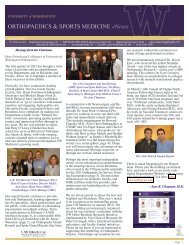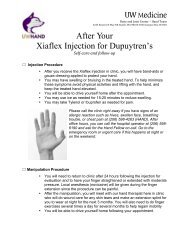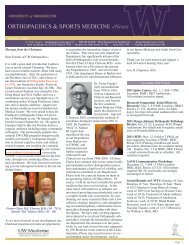2002 - University of Washington Bone and Joint Sources
2002 - University of Washington Bone and Joint Sources
2002 - University of Washington Bone and Joint Sources
Create successful ePaper yourself
Turn your PDF publications into a flip-book with our unique Google optimized e-Paper software.
Figure 2: Electrophoresis <strong>of</strong> molecular sieve fractionated type II collagen from fetal bovine epiphyseal<br />
cartilage on SDS-5% PAGE. Collagen samples were run under non-reducing <strong>and</strong> reducing conditions.<br />
Arrows show the type II collagen fraction that appears to be disulfide bonded. The reduced protein<br />
was blotted to PVDF membrane <strong>and</strong> identified by N-terminal sequence analysis.<br />
To define precisely the sites <strong>of</strong><br />
intermolecular cross-linking, a mAb<br />
2B4 affinity column was used to purify<br />
cross-linked CB peptides that<br />
contained α1(IX)NC1 from a CB digest<br />
<strong>of</strong> human type II collagen. A<br />
methionine in this domain ensures its<br />
release as a short peptide. Peptides<br />
eluted from the affinity column were<br />
further purified by RP-HPLC then<br />
SDS-PAGE. Western blot analysis was<br />
performed with mAb 2B4.<br />
Amino-terminal sequence analysis<br />
<strong>of</strong> the purified peptide identified it as<br />
α1(IX)NC1 cross-linked to a helical site<br />
in α1(II) CB9,7, which most likely is the<br />
known 930 hydroxylysine cross-linking<br />
residue. The discovery <strong>of</strong> this domain<br />
<strong>of</strong> type IX collagen linked to the type II<br />
collagen triple helix was not predicted<br />
from earlier methods <strong>of</strong> finding as<br />
cross-linking sites in the collagen IX<br />
molecule (Figure 1). It was known that<br />
type IX collagen is extensively crosslinked<br />
in cartilage matrix through lysyl<br />
oxidase-mediated bonds to both N-<br />
<strong>and</strong> C- telopeptides <strong>of</strong> type II collagen<br />
<strong>and</strong> between the type IX collagen<br />
molecules themselves through the<br />
α3(IX)NC1 domain. The finding <strong>of</strong><br />
α1(IX)NC1 links to type II collagen,<br />
taken with other properties <strong>of</strong> fibril<br />
associated collagen molecules, suggest<br />
that the initial docking <strong>and</strong> crosslinking<br />
<strong>of</strong> type IX molecules on type II<br />
fibrils occurs through the COL1/NC1<br />
domain interacting with the hole region<br />
<strong>of</strong> the quarter-staggered assembly<br />
(Figure 3).<br />
RECOMMENDED READING<br />
Mendler M, Eich-Bender S G, Vaughan<br />
L, Winterhalter KH, Bruckner P. (1989)<br />
Cartilage contains mixed fibrils <strong>of</strong><br />
collagen types II, IX, <strong>and</strong> XI. J. Cell Biol.<br />
108, 191-197.<br />
Figure 3: Collagen IX / II cross-linking interactions: working model.<br />
Wu JJ, Woods P E, Eyre DR. (1992)<br />
Identification <strong>of</strong> cross-linking sites in<br />
bovine cartilage type IX collagen reveals<br />
an antiparallel type II-type IX<br />
molecular relationship <strong>and</strong> type IX to<br />
type IX bonding. J. Biol. Chem. 267,<br />
23007-23014.<br />
Diab M, Wu JJ, Eyre DR. (1996)<br />
Collagen type IX from human cartilage:<br />
a structural pr<strong>of</strong>ile <strong>of</strong> intermolecular<br />
cross-linking sites. Biochem. J. 314, 327-<br />
332.<br />
Bönnemann CG, Cox GF, Shapiro F, Wu<br />
JJ, Feener CA, Thompson T, Anthony<br />
DC, Eyre DR, Darras B, Kunkel LM.<br />
(2000) A mutation in the a3 chain <strong>of</strong><br />
type IX collagen causes autosomal<br />
dominant multiple epiphyseal dysplasia<br />
with mild myopathy. Proc. Natl. Acad.<br />
Sci. USA 97, 1212-1217.<br />
van der Rest M, Mayne R. (1989) Type<br />
IX collagen. In: Structure <strong>and</strong> Function<br />
<strong>of</strong> Collagen Types (Mayne R. <strong>and</strong><br />
Burgeson RE, eds.), pp. 195-221,<br />
Academic Press.<br />
Atley LM, Shao P, Ochs V, Shaffer K,<br />
Eyre DR. (1998) Matrix<br />
metalloproteinase-mediated release <strong>of</strong><br />
immunoreactive telopeptides from<br />
cartilage type II collagen. Trans.<br />
Orthop. Res. Soc., 23, 850.<br />
44 <strong>2002</strong> ORTHOPAEDIC RESEARCH REPORT















